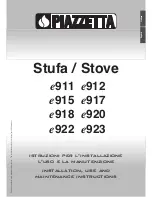
MONOBLOCCO Easy Line
cod. 004770520 - 01/2010
25/60
GB
D
It is always advisable for the user to call our assistance
service when they need qualified technicians.
If other technicians are called in, please make sure
they are truly qualified.
Before starting the assembly or dismantling phases
of the machine, the installer must comply with the
safety precautions as established by law, and in
particular as regards:
A) he must not work in adverse conditions;
B) he must be in perfect psychophysical condition to
work and ensure that the individual and personal
accident prevention devices are sound and in perfect
working order;
C) he must wear accident prevention gloves;
D) he must wear safety shoes;
E) he must make sure that the area he is working in
for assembling/dismantling the stove is free from
obstacles.
5.2
FLUES AND CHIMNEY CAPS
The flue pipe for the discharge of smoke must be
compliant with standards UNI 10683, EN 1856-1-2,
EN 1857, EN 1443, EN 13384-1-3, EN 12391-1 both
in terms of size and materials used to construct it.
• FLUE dimensions must comply with the instructions
given in the technical data sheet (medium draught 12
Pa with the door closed). It is advisable to use flues
insulated with a refractory material or in stainless steel
with a circular cross section and smooth internal walls
(Fig. 5.2.1). Flue cross-section should be kept constant
for all its height. A minimum height of 3.5÷4 m is
recommended (see Fig.5.2.2). Under the outlet of the
smoke pipe there should be a chamber for gathering
solid materials and any condensation.
DETERIORATING flues made with unsuitable
materials such as asbestos cement, galvanised steel,
etc., with a rough or porous internal surface are illegal
and can jeopardise the correct operation of the stove.
• A PERFECT DRAUGHT is above all the result of a flue
that is clear of obstructions such as chokes, horizontal
sections or corners; any axial displacements should
be at a maximum angle of 45° compared to the vertical
axis, (better still if it is only 30°). These displacements
should preferably be effected near the chimney top.
• The SMOKE connection between the stove and flue
should have the same cross section as the stove’s
smoke outlet. The smoke fitting must be sealed and
the use of flexible metallic pipes is prohibited.
Changes in direction in respect to the smoke outlet of
the appliance must be executed using elbows not
exceeding 45° in respect to vertical.
• The CHIMNEY TOP shall be the WINDPROOF type
with an inside cross section equivalent to that of the
flue and with a smoke outlet passage section at least
DOUBLE the internal one of the flue (Fig. 5.2.3).
• To avoid draught problems, each stove should have
its own flue. If there is more than one flue on the roof the
others should be situated at a distance of at least 2
metres and the stove’s chimney top should be at least
40 cm ABOVE the others (Fig. 5.2.3). If the chimney
tops are near each other install some dividing panels.
• the data in the table of the UNI 10683 rules regarding
ausreichen, eine Platte zur Lastverteilung mit
entsprechender Größe verwenden.
Die Maßnahmen zur Montage und zum Zerlegen des
Kaminofens dürfen nur von Fachpersonal durchgeführt werden.
Es ist immer empfehlenswert, sich für die Anforderung
von qualifizierten Technikern an eine unserer
Kundendienststellen zu wenden.
Sollten andere Techniker eingreifen, sind deren
Fähigkeiten unbedingt sicherzustellen.
Der Installateur hat vor der Montage oder dem
Zerlegen des Geräts alle gesetzlich vorgesehenen
Sicherheitsmaßnahmen und insbesondere die
folgenden zu beachten:
A) Nicht bei ungünstigen Bedingungen vorgehen;
B) Unter einwandfreien psychophysischen
Bedingungen arbeiten und sicherstellen, dass die
individuellen und persönlichen
Unfallverhütungsvorrichtungen komplett sind und
einwandfrei funktionieren;
C) Schutzhandschuhe tragen;
D) SchutztÿËuhe tragen;
E) Sicherstellen, dass der für die Montage bzw. das
Zerlegen nötige Bereich keine Hindernisse aufweist.
5.2
RAUCHFÄNGE UND SCHORNSTEINE
Der Rauchfang für die Ableitung der Rauchgase muss
unter Beachtung der Normen UNI 10683, EN 1856-1-
2, EN 1857, EN 1443, EN 13384-1-3, EN 12391-1
angelegt werden, sowohl was seine Größe betrifft als
auch das für seinen Bau verwendete Material.
• Die Maße des RAUCHFANGS müssen den Angaben
des technischen Datenblattes (bei geschlossener Tür
Abzug medium 12Pa) entsprechen. Es wird die
Verwendung von runden, isolierten Rauchfängen aus
Schamotte oder Edelstahl, die an den Innenwänden
eine glatte Oberfläche haben, empfohlen (Abb. 5.2.1).
Der Durchmesser des Rauchfangs muss über seine
gesamte Länge gleich sein. Es wird eine Mindesthöhe
von 3,5÷4 m empfohlen (siehe Abb.5.2.2). Es ist
außerdem empfehlenswert, an der Mündung des
Rauchkanals eine Kammer vorzusehen, in der
Feststoffe und eventuelle Kondensflüssigkeit
aufgefangen werden.
BAUFÄLLIGE Rauchfänge aus ungeeignetem Material
(Asbestzement, verzinktem Stahl, usw. ... mit einer
rauen und porösen Innenfläche) entsprechen nicht
den geltenden Gesetzen und beeinträchtigen den
einwandfreien Betrieb des Ofens.
• Ein PERFEKTER RAUCHABZUG wird vor allem durch
einen von Hindernissen, wie z.B. Verstopfungen,
waagrechten Verläufen und Kanten freien Rauchfang
gewährleistet; eventuelle horizontale Versetzungen
sind so auszuführen, dass das Rohr in einem 45°
Winkel zur Senkrechten verläuft, besser noch in einem
30° Winkel. Diese Versetzungen sollten möglichst in
der Nähe des Schornsteins vorgenommen werden.
• Der RAUCHANSCHLUSS zwischen Ofen und
Rauchfang muss denselben Schnitt des
Rauchausgangs des Ofens aufweisen. Der
Rauchanschluss muss dicht sein und die
Verwendung von biegsamen Metallrohren ist verboten.
Richtungsänderungen, bezogen auf den Rauchaustritt
des Geräts, müssen mit Knien nicht über 45° zur
















































